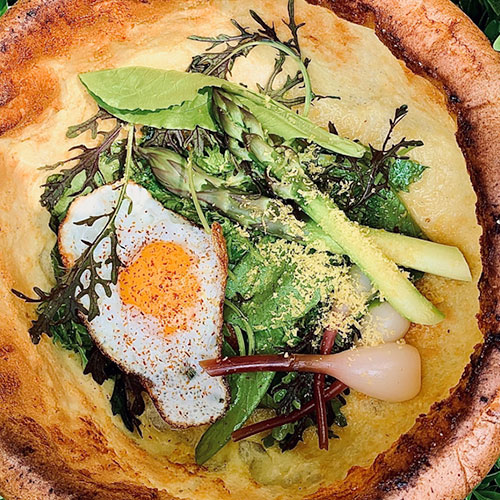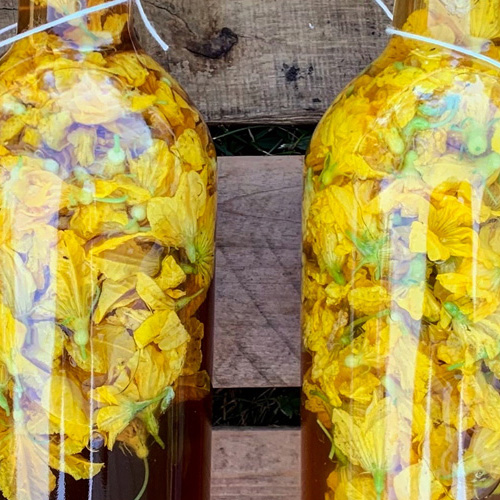Nothing much is happening. Syrup season has come and gone. Planting season is still weeks away. The ground feels like a lifeless sponge under my feet. This is spring purgatory. It’s the time of year when we reorganize our seed packets and watch the weather. It’s also a time to take stock of the past season. I can go back and taste any harvests that we put in jars, like the ten quarts of tomatoes still left in our pantry.
Each summer, my mom cans all the tomatoes that we don’t eat fresh. I try to stretch the stock into late spring, to give us something to look forward to until we’re coming up on a new harvest. Today, I’m thinking about pizza.
We make pizza every week. We live for it. In the past year, we’ve dialed in our dough, decided on our favorite toppings, and picked up a few tricks that I’m ready to share.
The sauce is easy. I open a quart jar and remove each tomato with a fork, leaving the juice for later. I put the tomatoes in a large bowl, crush them with a spoon, and add a pinch of salt. Then come the toppings. We still have ramps, onions, green beans, and all kinds of peppers in jars. I want the alliums and peppers on the pizza. I’ll eat the spicy dilly beans as a snack while I’m cooking. They go well with cold beer.
We make pizza every week. We live for it. In the past year, we’ve dialed in our dough, decided on our favorite toppings, and picked up a few tricks that I’m ready to share.
The dough is easy, too. Start with 500 grams (roughly 4 ½ cups) of flour—a mix of bread flour, all-purpose flour, and no more than 50 grams (just under ½ cup) of whole wheat flour. I’ve ground my own flour, bought it from neighbors, used grocery store brands, and mail-ordered bags from all over the country. Regardless of the source, I like a little bit of whole wheat for extra body, texture, and flavor. The mix changes weekly, depending on what I have on hand. Then, add 100 grams (just under ½ cup) of sourdough starter. (My starter is loose, at 100% hydration—equal parts flour and water. Adjust accordingly if you need to.) 300 grams (about 1 ⅓ cup) of water come next, followed by 10 grams each of kosher salt (roughly 2 tsp. to 1 tbsp., depending on what kind of salt you use), honey (roughly 1-2 tsp.), and a neutral oil (roughly 1 tbsp.). Thoroughly mix the dough and knead until smooth and elastic, preferably using a stand mixer fitted with a dough hook, which should take about 10 minutes.
(Editor’s note: We’ve done our best to translate weight into volume, but we highly recommend weighing your ingredients for this and other baking projects. A good kitchen scale isn’t too expensive, will last for years, and will make your life easier and your results better.)
This recipe makes enough dough for two fourteen-inch pizzas. You can make the dough a few hours ahead of time or, for extra flavor, let it slowly ferment in the refrigerator for up to five days. You can also freeze it for later meals.
When you’re ready to build the pizza, preheat the oven to 450°F.
Pick up a dough ball with oiled fingers and press it evenly into a fourteen-inch pizza pan. (If you don’t have a pizza pan, just stretch the dough into a fourteen-inch round. You can bake it on an inverted baking sheet or, better, build it on a pizza peel and shovel it onto a baking stone or steel.) Then, build your layers. Start with sauce. Add cheese. I like a combination of mozzarella, parmesan, and asiago. In our house, we follow that with a single layer of pepperoni, then thinly sliced pickled ramps or onions, and finally, pickled peppers. The whole pan goes into the preheated oven for about twenty minutes, or until the crust is thoroughly browned.
Here’s the number one lesson I’ve learned from more than a hundred homemade pizzas: What comes after the bake is just as important as what comes before. This time of year, I like to finish my pies with thinly sliced smoked garlic, shaved cured egg yolk, dried garden herbs, and smoked and dried chile flakes. I’ve just recently gotten into smoked black pepper. A finish like that takes pizza up a level. As the year goes on, fresh herbs and chiles will replace dried and green garlic will replace smoked garlic. We might pile on spring greens dressed in a light vinaigrette. You get it.
If you canned or otherwise preserved your harvest last year, there’s a good chance you have just enough left to prime you for all the work to come. Crack a beer, enjoy your pizza, and let those flavors wash away the grays of the current season.




